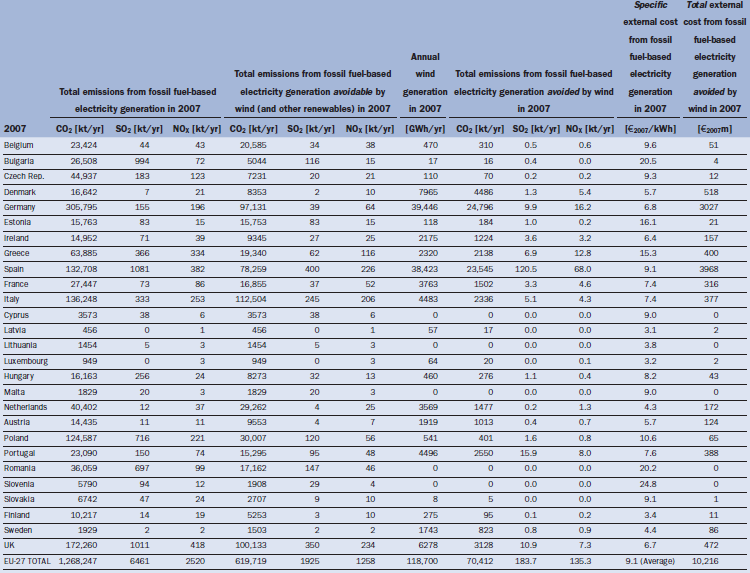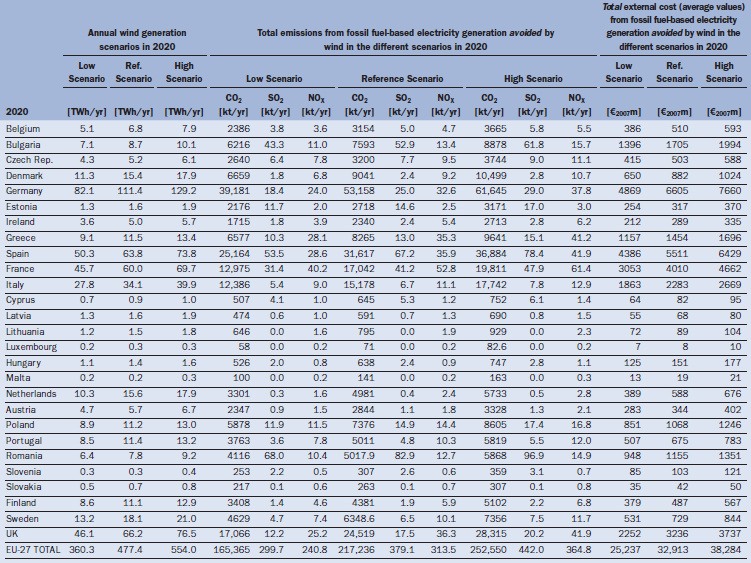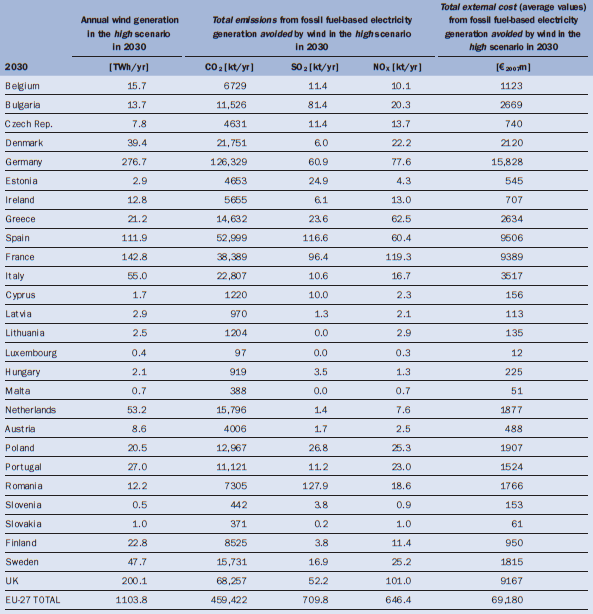MAIN PUBLICATION :
| Home � ENVIRONMENT � Environmental Benefits.. � Conclusions |

|
Environmental Benefits of Wind Energy - Concluding Remarks
Empirical analyses in previous sections impressively demonstrate that there exist significant environmental benefits of wind generation compared to conventional electricity generation in the EU-27 Member States.
In 2007, total annual wind generation of 118.7 TWh per year on EU-27 Member States level has already avoided 70,412 kt per year of CO2, 183.7 kt per year of SO2, 135.3 kt per year of NOx (see Table 5.1). The countries mainly contributing to these 2007 results in the EU Member States are Germany, Spain, Denmark, and UK.
Table 5.1. Empirical Results on Avoided Emissions and External Cost due to Wind Generation in the EU-27 Member States in 2007.

Source: Based on Auer et al. (2007)
In the next decade the share of wind generation will increase considerably in the European power plant mix. Moreover, mainly due to offshore wind deployment (but also a continual increase of onshore wind), the amount of fossil fuel-based electricity generation replaced by wind generation will increase further in all of the three wind deployment scenarios analysed (see Figure 5.2).
Table 5.2. Empirical Results on Avoided Emissions and External Cost due to Wind Generation in the Different Wind Deployment Scenarios in the EU-27 Member States in 2020.

Source: Based on Auer et al. (2007)
At aggregated EU-27 Member State level, the following amounts of emissions and external cost are avoided due to wind generation in the different wind deployment scenarios:
- Reference scenario (477.4 TWh per year - avoided emissions CO2: 217,236 kt per year, SO2: 379.1 kt per year, NOx: 313.5 kt per year; avoided external cost: €200732,913 million;
- High scenario (554.0 TWh per year) - avoided emissions CO2: 252,550 kt per year, SO2: 442.0 kt per year, NOx: 364.8 kt per year; avoided external cost: €200738,284 million;
- Low scenario (360.3 TWh per year) - avoided emissions: CO2: 165,365 kt per year, SO2: 299.7 kt per year, NOx: 240.8 kt per year; avoided external cost: €200725,237 million.
Finally, in the high scenario for the year 2030 (1,103.8 TWh per year; see Table 5.3), the estimates of the environmental benefits of wind generation (compared to fossil fuel-based electricity generation) are CO2: 459,422 kt per year, SO2: 709.8 kt/yr, NOx: 646.4 kt per year in terms of avoided emissions and: €200769,180 million in terms of avoided external cost.
Table 5.3. Empirical Results on Avoided Emissions and External Cost due to Wind Generation in the High Wind Deployment Scenario in the EU-27 Member States in 2030.

Source: Based on Auer et al. (2007)
The analyses and results presented above impressively underpin the importance of further significantly increasing the share of wind deployment (onshore and offshore) in the EU-27 Member States in the next decades. A precondition for the full implementation of the environmental benefits estimated here is both continuous adaption of financial support instruments and the removal of several barriers for market integration of wind energy.
Annex Chapter 5
Table 5.A briefly summarises the methodology for specific countries or regions of each of the 'early' studies on external costs in the late 1980s and the beginning of the 1990s.
Table 5.A: Methodologies of External Cost Studies
| Study | Methodology | Location |
| Hohmeyer and Colleagues (1988) | Top-down apportioning of total environment damages in Germany to the fossil-fuel sector | Germany; existing power plants |
| Ottinger et al (1990) | Damage base approach in which values were taken from a literature review or previous studies | US; existing power plants |
| Pearce (1992) | Literature survey to identify values used in a damage-based approach to calculate damages. In some respects an update of Ottinger et al (1990) Study from Pace University Center | Estimates for a new and old coal power plant in UK |
| US Department of Energy ORNL/RFF (1994) | Damage function, or impact pathway, approach. Detailed examination and use of scientific literature. Emphasis on developing methodology, rather than on numerical results of specific examples | Estimates for new power plants in rural southwest and southeast US |
| RCG/Tellus (1994) | Damage function approach. Developed EXMOD software | Sterling; rural area in New York state |
Source: Lee (1996)
>> Chapter 6: Social acceptance of wind energy and wind farms
| Acknowledgements | Sitemap | Partners | Disclaimer | Contact | ||
|
coordinated by  |
supported by  |
The sole responsibility for the content of this webpage lies with the authors. It does not necessarily reflect the opinion of the European Communities. The European Commission is not responsible for any use that maybe made of the information contained therein. |
